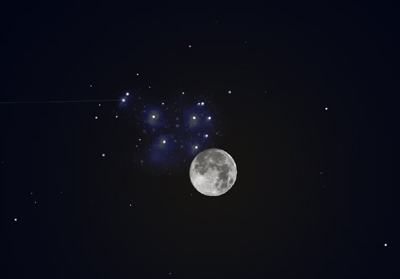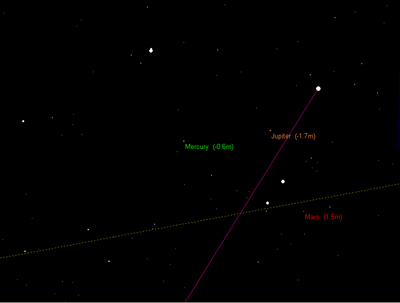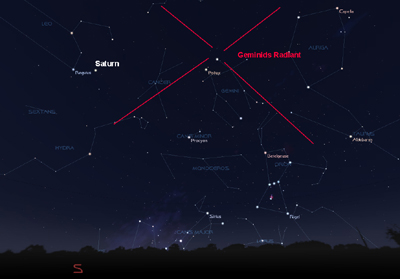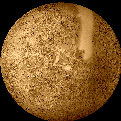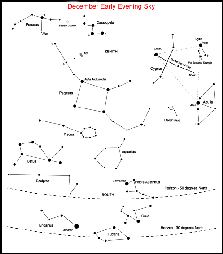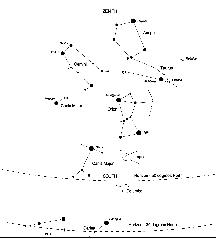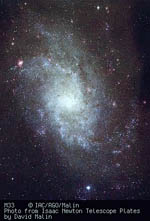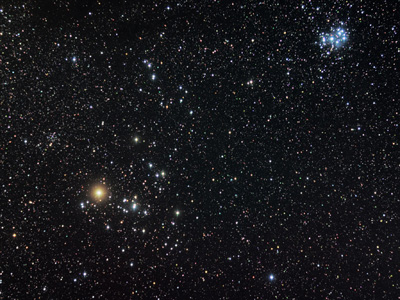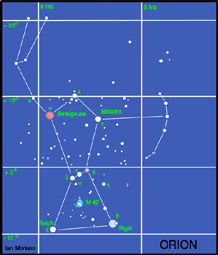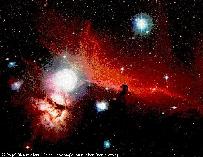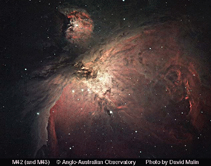The Night Sky December 2006
Compiled by Ian Morison
This page, updated monthly, will let you know some of the things that you can look out for in the night sky. It lists the phases of the Moon, where you will see the naked-eye planets and describes some of the prominent constellations in the night sky during the month.
Image of the Month
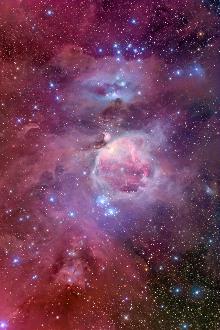
The Sword of Orion - click on image to download full size picture
Image: Credit and Copyright - Jon Christensen
The Sword of Orion
This wonderful image shows the region, called the Sword of Orion, that can be seen with the unaided eye below the three stars of Orion's belt. It is one of the nearer star formation regions to our Sun at a distance of 1500 light years. The region is "illuminated" by the light from a group of very hot bright stars in the centre of the Orion nebula called the "trapezium". The dust scatters the visible light from the stars and has a blusih tinge, whilst the ultraviolet light excites the hydrogen gas and causes it to give off the red Hydrogen Alpha emission line. The Orion Nebula contains many stellar nurseries. It spans 40 light years and is the 42nd entry in Messier's catalogue hence its other name, M42.
See more of John Christensen's images
The Moon
| new | first quarter | full moon | last quarter |
|---|---|---|---|
| Dec 20th | Dec 28th | Dec 5th | Dec 11th |
Some Lunar Images by Ian Morison, Jodrell Bank Observatory: Lunar Images
Highlights of the Month
December 4th:2 - 4 am - The Moon occults the Pleiades Cluster
The Pleiades cluster is 4 degrees north of the Ecliptic but, as the Moon's orbit inclined at 5 degrees to the ecliptic it can pass in front of the cluster. If this happens when the Moon is not too far before of after New Moon, it is a beautiful sight, but this month the Moon is nearly full. There will thus the glare of the Moon to contend with, and the stars that make up the cluster will not be easy to spot. However it will be worth observing the leading limb of the Moon as it occults the brighter stars of the cluster. There will still be a thin strip of unlight Moon behind which the stars will be seen to dissapear. From London, the brightest member of the cluster will be occulted at 04:03:36 and reappear about 53 minutes later. The image contrast of a telescope will be severely tested for these observations and a refractor will almost certainly be a good choice to observe with if you have one.
.
Dawn, December 9t-11th: a close grouping of three planets
Just before dawn on the mornings of December 9th, 19th and 11th you may be able to glimpse three of the planets that have been hidden in the Sun's glare for nearly a month. Binoculars will certainly help and you will need a very low eastern horizon to see them before they are masked by sunlight in the sky. But it certainly worth a try. In the chart above, for the morning of the 11th, the Sun's light has been masked so you can see the positions of the three planets. It will not be so easy in reality! they will all be encompassed within just over a degree so there is a chance for a nice image taken with a telescope and camera attached.
December 14th after midnight: look out for the Geminid Meteor Shower - and spot Saturn too.
The Geminids
In the early morning of December 14th will give us the chance, if clear, of observing what may be the best meteor shower this year. Any time after midnight you might see as many as 120 meteors an hour under dark and transparent skies - over one a minute. The relatively slow moving meteors arise from debris released from the asteroid 3200 Phaethon. Unusual, as most meteor showers come from comets. The radiant - where the meteors appear to come from - is close to the bright star Castor in the constellation Gemini as shown on the chart above. If it is clear it will be cold - so wrap up well, wear a woolly hat and have some hot drinks with you. It could well be worth it!
Saturn
Looking east across towards Leo you should spot an interloper which is the brightest object in that part of the sky. It is the planet Saturn!
.
The Planets
Jupiter
Jupiter lying in the constellation Libra, passed behind the Sun during the early part of November but, by December's start, may just be becoming visible when it rises 30 minutes before the Sun low in the south-east. As the month continues it will rise earlier - its seperation from the Sun increasing from 7 degrees to 32 degrees and it will rise 90 minutes before the Sun by months end. Jupiter will be a morning object for several months yet. Sadly, as Jupiter moves on from Libra into Scorpius (on the 6th of December) it will lie along the most southerly part of the ecliptic and will never reach the high elevations in the sky that we have enjoyed in recent years so our views will be hindered by the atmosphere. A trip to Hawaii would be just the ticket! See highlight above.
Saturn
Saturn is in the constellation Leo and about 5 degrees up and to the right of its brightest star Regulus at the start of December. As the month progresses Saturn moves back along the ecliptic - called retrograde motion - due to the Earth's own motion around the Sun and hence our changing viewpoint. It rises in the east north-east at ~ 9:30 pm as December starts and is due south and highest in the sky at ~ 4 am. Its magnitude is ~ +0.4 and its globe subtends an angle of ~20 arc seconds. The rings are closing and are now about 15 degrees from edge-on, so Saturn, at magnitude +0.4, is shining less brightly than during the previous few years when the rings have been more open. Saturn is still, however, a beautiful sight in a small telescope. A 4 to 6 inch telescope will also easily show Saturn's largest moon Titan, and an 8 inch three or four more.
The image was taken as the Cassini spacecraft neared Saturn at the start of its exploration of the planet and its moons - particularly Titan.
Mercury
Mercury passed in front of the Sun on November 9th - a transit was visible around the Pacific Ocean but, sadly, not in Europe. and reached its western elongation on November 25th. During the first two weeks of December it may be picked out with binoculars just before dawn ( at ~ 5:30) in the east south-east. It will have a magnitude of ~ -0.7 and, given a low eastern horizon, should be fairly easy to spot in the hour before dawn. see highlight above.
Note that the blank region in the image above is simply because this part of Mercury's surface has not yet been imaged in detail.
Mars
Mars reappeared in the pre-dawn sky at the very end of November about 45 minutes before sunrise. during December it gradually rises earlier than the Sun so is easier to see It will be at magnitude +1.5, but its disk will be just ~5 arc seconds across so no details will be seen on the salmon pink surface. - see highlight above.
Venus
Venus passed behind the Sun on October 27th so, at magnitude -3.9, is now on the eastern side of the Sun becoming visible after the sunset. It should be spotted with binoculars in the south-west just after sunset at the very beginning of December, but sets later and become easier to spot as the month progresses!
Find more planetary images and details about the Solar System: The Solar System
The Stars
The Early Evening December Sky
The Late Evening December Sky
This maps shows the constellations seen towards the south in early and late evening. Setting towards the west in early evening is the beautiful region of the Milky Way containing both Cygnus and Lyra. Below is Aquilla. The three bright stars Deneb (in Cygnus), Vega (in Lyra) and Altair (in Aquila) make up the "Summer Triangle". East of Cygnus is the great square of Pegasus - adjacent to Andromeda in which lies M31, the Andromeda Nebula. To the north lies "w" shaped Cassiopeia and Perseus. The lower map shoesthe constellation Taurus, with its two lovely clusters, the Hyades and the Pleaides, and is also described in more detail below. as the evening draws on, Orion, the Hunter, follows Taurus into the eastern sky with the constellations Auriga, above, and Gemini, to the upper left. Later Sirius, in Canis Major will be seen to the lower left of Orion. Due to its brightness and scintillations caused by the atmosphere it often appears as a rainbow of colours flashing in the sky.
The constellations Lyra and Cygnus
This month the constellations Lyra and Cygnus are seen almost overhead as darkness falls with their bright stars Vega, in Lyra, and Deneb, in Cygnus, making up the "summer triangle" of bright stars with Altair in the constellation Aquila below. (see sky chart above)
Lyra
Lyra is dominated by its brightest star Vega, the fifth brightest star in the sky. It is a blue-white star having a magnitude of 0.03, and lies 26 light years away. It weighs three times more than the Sun and is about 50 times brighter. It is thus burning up its nuclear fuel at a greater rate than the Sun and so will shine for a correspondingly shorter time. Vega is much younger than the Sun, perhaps only a few hundred million years old, and is surrounded by a cold,dark disc of dust in which an embryonic solar system is being formed!
There is a lovely double star called Epsilon Lyrae up and to the left of Vega. A pair of binoculars will show them up easily - you might even see them both with your unaided eye. In fact a telescope, provided the atmosphere is calm, shows that each of the two stars that you can see is a double star as well so it is called the double double!
Between Beta and Gamma Lyra lies a beautiful object called the Ring Nebula. It is the 57th object in the Messier Catalogue and so is also called M57. Such objects are called planetary nebulae as in a telescope they show a disc, rather like a planet. But in fact they are the remnants of stars, similar to our Sun, that have come to the end of their life and have blown off a shell of dust and gas around them. The Ring Nebula looks like a greenish smoke ring in a small telescope, but is not as impressive as it is shown in photographs in which you can also see the faint central "white dwarf" star which is the core of the original star which has collapsed down to about the size of the Earth. Still very hot this shines with a blue-white colour, but is cooling down and will eventually become dark and invisible - a "black dwarf"! Do click on the image below to see the large version - its wonderful!
M56 is an 8th magnitude Globular Cluster visible in binoculars roughly half way between Alberio (the head of the Swan) and Gamma Lyrae. It is 33,000 light years away and has a diameter of about 60 light years. It was first seen by Charles Messier in 1779 and became the 56th entry into his catalogue.
Cygnus
Cygnus, the Swan, is sometimes called the "Northern Cross" as it has a distinctive cross shape, but we normally think of it as a flying Swan. Deneb,the arabic word for "tail", is a 1.3 magnitude star which marks the tail of the swan. It is nearly 2000 light years away and appears so bright only because it gives out around 80,000 times as much light as our Sun. In fact if Deneb where as close as the brightest star in the northern sky, Sirius, it would appear as brilliant as the half moon and the sky would never be really dark when it was above the horizon!
The star, Albireo, which marks the head of the Swan is much fainter, but a beautiful sight in a small telescope. This shows that Albireo is made of two stars, amber and blue-green, which provide a wonderful colour contrast. With magnitudes 3.1 and 5.1 they are regarded as the most beautiful double star that can be seen in the sky.
Cygnus lies along the line of the Milky Way, the disk of our own Galaxy, and provides a wealth of stars and clusters to observe. Just to the left of the line joining Deneb and Sadr, the star at the centre of the outstretched wings, you may, under very clear dark skys, see a region which is darker than the surroundings. This is called the Cygnus Rift and is caused by the obscuration of light from distant stars by a lane of dust in our local spiral arm. the dust comes from elements such as carbon which have been built up in stars and ejected into space in explosions that give rise to objects such as the planetary nebula M57 described above.
There is a beautiful region of nebulosity up and to the left of Deneb which is visible with binoculars in a very dark and clear sky. Photographs show an outline that looks like North America - hence its name the North America Nebula. Just to its right is a less bright region that looks like a Pelican, with a long beak and dark eye, so not surprisingly this is called the Pelican Nebula. The photograph below shows them well.
Brocchi's Cluster An easy object to spot with binoculars in Gygnus is "Brocchi's Cluster", often called "The Coathanger",although it appears upside down in the sky! Follow down the neck of the swan to the star Alberio, then sweep down and to its lower left. You should easily spot it against the dark dust lane behind.
The constellations Pegasus and Andromeda
Pegasus
The Square of Pegasus is in the south during the evening and forms the body of the winged horse. The square is marked by 4 stars of 2nd and 3rd magnitude, with the top left hand one actually forming part of the constellation Andromeda. The sides of the square are almost 15 degrees across, about the width of a clentched fist, but it contains few stars visibe to the naked eye. If you can see 5 then you know that the sky is both dark and transparent! Three stars drop down to the right of the bottom right hand corner of the square marked by Alpha Pegasi, Markab. A brighter star Epsilon Pegasi is then a little up to the right, at 2nd magnitude the brightest star in this part of the sky. A little further up and to the right is the Globular Cluster M15. It is just too faint to be seen with the naked eye, but binoculars show it clearly as a fuzzy patch of light just to the right of a 6th magnitude star.
Andromeda
The stars of Andromeda arc up and to the left of the top left star of the square, Sirra or Alpha Andromedae. The most dramatic object in this constellation is M31, the Andromeda Nebula. It is a great spiral galaxy, similar to, but somewhat larger than, our galaxy and lies about 2.5 million light years from us. It can be seen with the naked eye as a faint elliptical glow as long as the sky is reasonably clear and dark. Move up and to the left two stars from Sirra, these are Pi amd Mu Andromedae. Then move your view through a rightangle to the right of Mu by about one field of view of a pair of binoculars and you should be able to see it easily. M31 contains about twice as many stars as our own galaxy, the Milky Way, and together they are the two largest members of our own Local Group of about 3 dozen galaxies.
M33 in Triangulum
If, using something like 8 by 40 binoculars, you have seen M31 as described above, it might well be worth searching for M33 in Triangulum. Triangulum is
the small faint constellation just below Andromeda. Start on M31, drop down to Mu Andromedae and keep on going in the same direction by the same distance as you have moved from M31 to Mu Andromedae. Under excellent seeing conditions (ie., very dark and clear skies) you should be able to see what looks like a little piece of tissue paper stuck on the sky or a faint cloud. It appears to have uniform brightness and shows no structure. The shape is irregular in outline - by no means oval in shape and covers an area about twice the size of the Moon. It is said that it is just visible to the unaided eye, so it the most distant object in the Universe that the eye can see. The distance is now thought to be 3.0 Million light years - just greater than that of M31.
The constellation Taurus
Taurus is one of the most beautiful constellations and you can almost imagine the Bull charging down to the left towards Orion. His face is delineated by the "V" shaped cluster of stars called the Hyades, his eye is the red giant star Aldebaran and the tips of his horns are shown by the stars beta and zeta Tauri. Although alpha Tauri, Aldebaran, appears to lie amongst the stars of the Hyades cluster it is, in fact, less than half their distance lying 68 light years away from us. It is around 40 times the diameter of our Sun and 100 times as bright.
More beautiful images by Alson Wong : Astrophotography by Alson Wong
To the upper right of Taurus lies the open cluster, M45, the Pleiades. Often called the Seven Sisters, it is one of the brightest and closest open clusters. The Pleiades cluster lies at a distance of 400 light years and contains over 3000 stars. The cluster, which is about 13 light years across, is moving towards the star Betelgeuse in Orion. Surrounding the brightest stars are seen blue reflection nebulae caused by reflected light from many small carbon grains. These relfection nebulae look blue as the dust grains scatter blue light more efficiently than red. The grains form part of a molecular cloud through which the cluster is currently passing. (Or, to be more precise, did 400 years ago!)
Close to the tip of the left hand horn lies the Crab Nebula, also called M1 as it is the first entry of Charles Messier's catalogue of nebulous objects. Lying 6500 light years from the Sun, it is the remains of a giant star that was seen to explode as a supernova in the year 1056. It may just be glimpsed with binoculars on a very clear dark night and a telescope will show it as a misty blur of light.
Its name "The Crab Nebula" was given to it by the Third Earl of Rosse who observed it with the 72 inch reflector at Birr Castle in County Offaly in central Ireland. As shown in the drawing above, it appeared to him rather lile a spider crab. The 72 inch was the world's largest telelescope for many years. At the heart of the Crab Nebula is a neutron star, the result of the collapse of the original star's core. Although only around 20 km in diameter it weighs more than our Sun and is spinning 30 times a second. Its rotating magnetic field generate beams of light and radio waves which sweep across the sky. As a result, a radio telescope will pick up very regular pulses of radiation and the object is thus also known a Pulsar. Its pulses are monitored each day at Jodrell Bank with a 13m radio telescope.
The constellation Orion
Orion, perhaps the most beautiful of constellations, will be seen in the south at around 11 - 12 pm during January. Orion is the hunter holding up a club and shield against the charge of Taurus, the Bull up and to his right. Alpha Orionis, or Betelgeuse, is a read supergiant star varying in size between three and four hundred times that of our Sun. The result is that its brightness varies somewhat. Beta Orionis, or Rigel, is a blue supergiant which, at around 1000 light years distance is about twice as far away as Betelgeuse. It has a 7th magnitude companion. The three stars of Orion's belt lie at a distance of around 1500 light years. Just below the lower left hand star lies a strip of nebulosity against which can be seen a pillar of dust in the shape of the chess-board knight. It is thus called the Horsehead Nebula. It shows up very well photographically but is exceedingly difficult to see visually - even with relativly large telescope.
Beneath the central star of the belt lies Orion's sword containing one of the most beautiful sights in the heavens - The Orion Nebula. It is a region of star formation and the reddish colour seen in photographs comes from Hydrogen excited by ultraviolet emitted from the very hot young stars that make up the Trapesium which is at its heart. The nebula, cradling the trapesium stars, is a beautiful sight in binoculars or, better still, a telescope. To the eye it appears greenish, not red, as the eye is much more sensitive to the green light emitted by ionized oxygen than the reddish glow from the hydrogen atoms.



